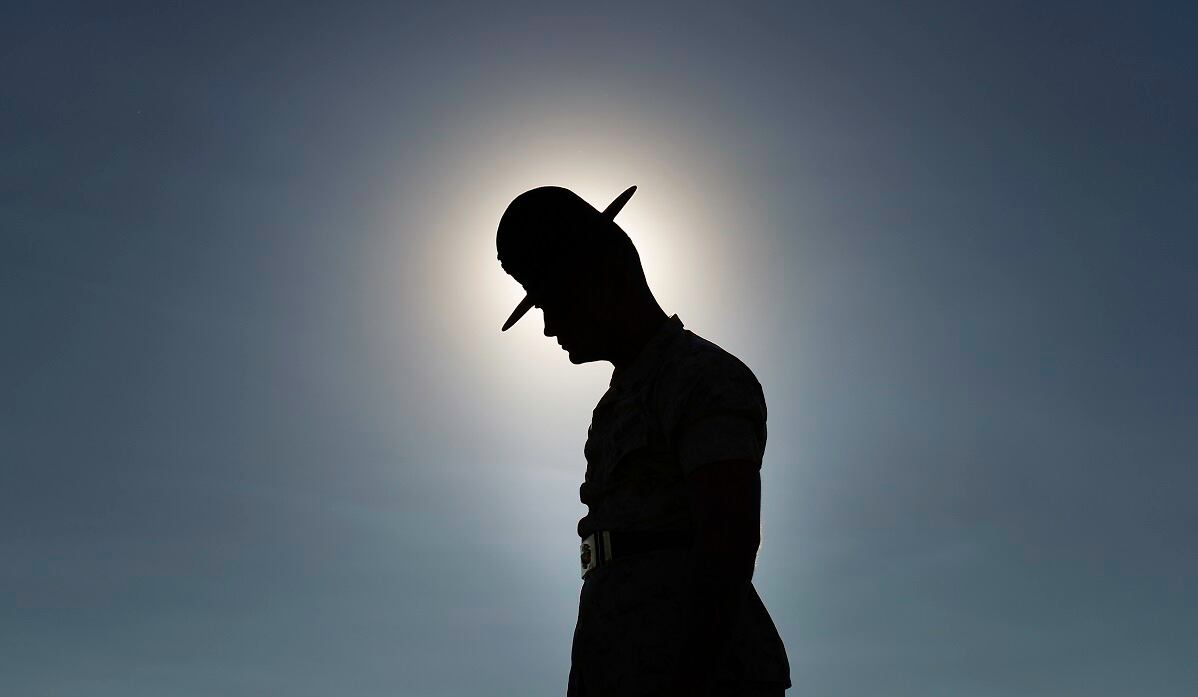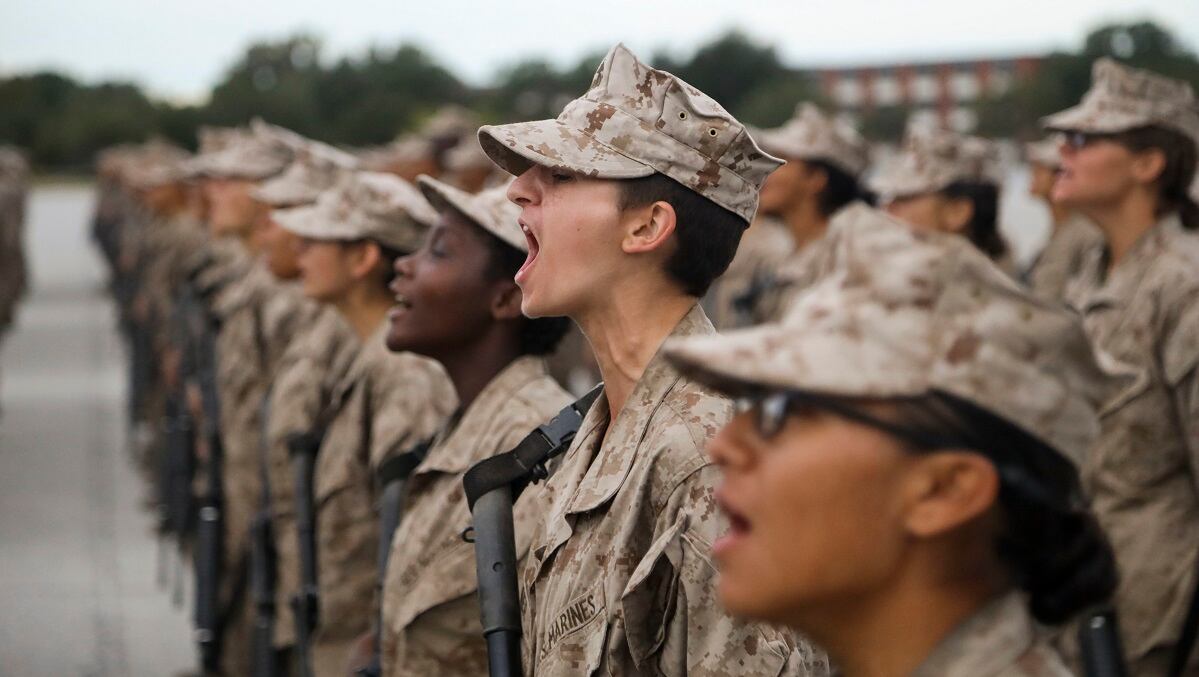The Marine Corps’ path to greater gender-integration at boot camp has been fraught with fears that turned out to be unfounded.
In 2015, a Marine spokesman said in a statement that recruits, who arrived on the yellow footprints with “immature, undeveloped and unfocused thoughts,” had to train divided by gender to limit distractions and bond with their same-gender drill instructor role model.
The following year, Brig. Gen. Austin “Sparky” Renforth, then commander of Marine Recruit Depot Parris Island, South Carolina, moved to gender-integrate some “70%” of boot camp training events, acting on a tasker from then-Commandant Gen. Robert Neller.
In 2017, Renforth said in an interview that those changes had gone smoothly, but if integration progressed beyond that, and happened earlier in training, male recruits might develop an unfavorable view of their female counterparts, who were more likely to grow up playing with “Barbie dolls” than engaging in contact sports.
Two years later, the Corps graduated its first partially integrated training company at Parris Island, South Carolina, and Commandant Gen. David Berger told lawmakers that the trial “went great.”
RELATED

In 2020, Berger said a congressional mandate to integrate training at both Marine Corps boot camps might drive the Corps to close the historic Parris Island, South Carolina, and open a new coed training depot better organized for the purpose.
The following year, during a visit to the previously all-male Marine Recruit Depot San Diego, Recruit Training Command leader Col. Matt Palma said the infrastructure changes needed to accommodate the first integrated recruit battalion turned out to be largely cosmetic: frosted windows for the female squad bays and “hygiene in progress” signs in the barracks to ensure privacy.
Now the Marine Corps is complying with a congressional directive to fully integrate training by 2025 and 2028 at Parris Island, South Carolina, and San Diego respectively, and considering a trove of data and recommendations from an independent study the service paid $2 million for that advances a compelling case for doing so at the platoon level.
But the head of Marine Corps Training and Education Command says the Corps is pursuing a different path, amid fears that complete integration will cause the force to lose its competitive edge for making the best warriors.
The language of the fiscal 2020 National Defense Authorization Act merely states that training at the two boot camps “may not be segregated based on gender.”
The ambiguity of that directive has allowed the Corps to set its own parameters for integration, but also bred confusion among training staff, leaders and recruits.
“A sizable number of Marine Corps respondents lacked a clear sense of how the Marine Corps defined gender integration at recruit training and thus used their own interpretation,” states the University of Pittsburgh-led study, which runs past 700 pages and was submitted to the service in summer 2022. “A vague definition enables latitude in implementation that is precluded by formal definitions. If the Marine Corps’s goal is progress, however, a formal, shared definition would set a benchmark for measuring results.”
Internally, the Marine Corps is embracing a model the study describes as “integrated company-plus,” in which male and female platoons are grouped into companies ― typically at a 5-to-1 ratio ― while integrating a number of training events below the platoon level.
The service, officials said, will eventually have its female recruit population evenly divided between the two boot camps and has created focus groups to explore further ways to integrate training events.
But leaders still remain protective of what Training and Education Command commander Lt. Gen. Kevin Iiams called the “alchemy” of Marine Corps training: the special process they say is essential to building Marines and requires the genders to train separately in their core units.
“There are protections that we have there; there is a willingness for recruits at that level to speak to leadership in manners that they would not have done otherwise,” Iiams said in a September interview. " We’re taking away those initial pieces of their identity and instilling what it is to be a Marine.”
Iiams insisted that the Corps’ outlier segregated approach to training resulted in the creation of elite warriors “better than any of the other services.”
“Do I feel that we create a superior product? I absolutely do,” he said. “Are there places where we can do better, where we can optimize and improve? I think we’re open-minded enough to continue to do that as we go to the future. But I think we’ve got the basics, fundamentally, right. We don’t want to change standards, we don’t want to change how tough we make them. We don’t want to change that essence of what it is to be a Marine, and earning the title of Marine.”
Marine veterans who spoke with University of Pittsburgh researchers, however, expressed concerns that the Marine Corps was falling short of a greater goal: to prepare recruits for life in the Marine Corps.
“You train like you fight — that saying should be a reality,” a male Marine veteran told study staff. “If we start segregated at any level, there is always going to be a perception that they are not good enough to be part of us from Day One.”
Keeping core aspects of training separated by gender created a cultural deficit that was difficult to overcome, interviewees said.
“I don’t think you can just say, like, ‘Oh well, we’ll deal with the integration later,’ because if you don’t have that foundation of integration, it’s really hard to tack it on afterwards,” a female veteran told researchers. “It’s like going back to trying to fix something with the foundation after you’ve already started building the house.”
The University of Pittsburgh study’s authors acknowledged that, of the three levels of integration they presented to the Marine Corps, which also include the “integrated company-plus” model the service is currently pursuing, and training under integrated drill instructor teams, the integrated platoon option represented the most work for the service. The integrated platoon model “provides the most direct and sustained opportunities for male and female recruits to work together, but … demands the most substantial change from current Marine Corps training processes,” they found.
Because Marine drill instructors consider every waking hour to be training time for recruits, a significant amount of formative training and instructions takes place in the squad bay. The study suggested that drill instructors could be responsible for one set of recruits in the squad bay and another set in integrated platoons, ultimately resulting in recruits receiving training from a larger number of drill instructors.
Two recruit leadership structures, or a rethinking of leadership positions, might be necessary to account for the different recruit groups, they added.
And while key training could still take place in the squad bay, procedures would have to be modified to ensure integrated platoons could train together. Also, because male recruits far outnumber female ones, not every recruit training company would have integrated platoons.
Worth it? Marine recruits and training staff generally thought not.
Less than 20% of recruits coming to the end of their training cycle said they wanted integration at the platoon level, according to the study, although female new Marines were more likely to support such a move.
Notably, though, interviewees from the other military services ― all of which conduct coed training at a platoon-equivalent level ― “overwhelmingly” defined gender-integrated training as taking place within platoons, and most saw it as necessary to fulfill the Corps’ mandate.
RELATED

“Participants with alternate viewpoints and Service leaders and training cadre from the other Services felt gender separation in training unintentionally reinforces or gives meaning to the separation promulgating women being seen as ‘less than,’ which could create issues in future training environments and the fleet,” researchers found.
Other parts of the study also describe some of the cultural problems the Marine Corps risks fostering with small training units that remain segregated by gender.
As previously reported, Iiams made an emergency visit to both boot camps to reinforce standards after a preliminary version of the study revealed some drill instructors were making crass and sexist comments to “break the ice” with their all-male platoons.
Within female platoons, the study found some concerns that drill instructors’ discussion of the sex assault risks women faced in the fleet were making recruits unproductively fearful and avoidant of the male Marines they’d soon work alongside.
The risk-conscious Marine Corps, deeply cognizant of its public image of a uniquely tough and hard-training force, is once again faced with a scenario in which the alleged perils are evident from the outset, and the benefits only likely to be seen in retrospect.
But in clinging to a model that keeps the genders separate in the closest training units, the Corps may find itself increasingly out of step with the American public it draws from and serves.
“As recruit training you … learn the intangible values ― honor, courage, and commitment,” a male Marine veteran told researchers. “Those are being taught at the platoon level, that’s where those lessons take place. That’s where the drill instructors teach you how to embody being a Marine. If gender integration is having respect for every person, seeing every person as a Marine, we’re missing the mark.”
Hope Hodge Seck is an award-winning investigative and enterprise reporter covering the U.S. military and national defense. The former managing editor of Military.com, her work has also appeared in the Washington Post, Politico Magazine, USA Today and Popular Mechanics.





